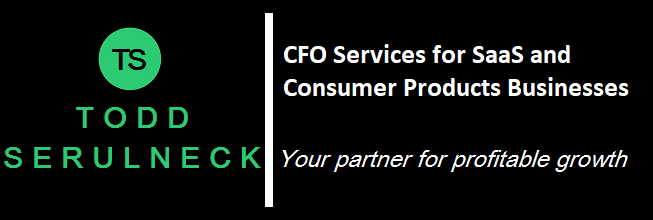5 Ways to Drive Quick Profits

Many SaaS business startups find themselves in a situation where we are generating some cash, but need a little more to break-even or to fund some additional spend. This is what I call SaaS Quick Profits. Once our operation is running and generating revenue, there are ways to get a quick boost in cash flow and profit. Here are five projects with low risk and minor investment:
1. Scrub Expenditures
This is the most boring task, but usually it results in something. Essentially, we review all expenditures for the past month or quarter. How necessary was this spend? Could it have been avoided or was there a less expensive way to get it done? Waste exists in almost all organizations and there is always some recurring expense that can be eliminated or reduced.
2. Review Pricing and Revenue Streams
I like this exercise because it involves growing the top line. We revisit the pricing model and our pricing tiers to see if it can be tweaked. Can a feature from the free platform be moved to the paid platform to increase its value and entice additional paid users? Can a price increase be taken on one of the pricing tiers? Can part of the service be shifted to transactional revenue? Are there other add-ons ready from the development team? Can we create a new revenue stream from white labeling, commissions to related services, or affiliate partners?
3. Seek Out R&D Tax Credits
Recent enhancements to the federal R&D tax credits make this item something that small businesses need to look at as an immediate source of cash. Specific to companies under $5M in gross receipts and less than 5 years of age, R&D tax credits can be used to offset the federal payroll tax and reduce AMT tax for small business owners. These credits can carry forward and can be claimed retroactively for three years. Several states also offer R&D tax credits. SaaS companies are ideal candidates for these credits. Activities that make good candidates for the credit include:
- Development of new products, features, or functionality.
- Improvement of existing products.
- Moving software services to the cloud
- Working on product scalability
4. Re-evaluate In-house vs. Outsourcing Decisions for Non-core Functions
There are always trade-offs between outsourcing and bringing a non-core function in-house. It is important that businesses are thoughtful about these decisions and understand that these decisions will change over time. Our business may have different needs than the last time this was evaluated. A change in this area can result in great expense savings for the business.
Functions that are generally non-core include accounting, finance, human resources, information technology, sales, marketing, manufacturing, logistics, and, yes, sometimes even operations.
In my mind, the decision revolves around whether you want to rent a competency or own it. Owning a competency creates a fixed cost for the business. There are costs associated with full-time employees (salaries, payroll taxes, benefits, training, and supervision). Once our business is operating at scale, it will make sense to shift work to in-house resources as they are less expensive, if fully utilized.
However, our businesses may not be able to fully utilize a resource or the need for the resource may be occasional or seasonal. In these instances, outsourcing can provide experienced help on a part-time or project basis and result in cost savings. This expense is now variable as it can be dialed up or down based on what is allowed by the contract and the fixed costs are avoided.
Often a hybrid-solution ends up getting used. Some of my clients will separate the strategic portion of the function from the tactical to get even more savings. For example, hiring an executive, but having all the staff outsourced. Or vice-versa… bringing the staff in house, but outsourcing the strategy and management of the staff.
5. Review Profitability by Segment
This is one of my favorite exercises. It requires some spreadsheet work and a dive into the accounting system, so the assistance of a professional helps. Simply put, not every customer is the same, so why are we treating them the same?
First, we segment your customers. Marketing may have already done this for us. If not, we can look at factors like which products or services they are consuming, how large they are, how much they are using your service, whether they like to pay you in a timely fashion or not, how long they have been using your service, or some other distinguishing factor. If you don’t have too many customers, it may make sense to look at this at the customer level and not bother with the segmentation.
We then break apart your revenue, gross margin, and expense structure. Revenue and direct costs are assigned by customer segment. Variable indirect costs are allocated. Fixed costs are pulled out to a different part of the analysis.
This is an enlightening process… and tells you which customer segments you are making money on and which ones you are not. In addition, you find out where your break-even revenue number is.
Now, for those segments or customers who end up being unprofitable, should we just let them go? We look at other factors like how fast their receipts are growing, was their lack of profitability a one-time event or due to onboarding costs, contract terms and renewal dates, and whether the loss of the customer will drop the company below a desired revenue number (like break-even revenue). Finally, before dropping an unprofitable customer or segment, perhaps renegotiating contracts for better pricing on the next renewal makes more sense.
SaaS Quick Profits Resources and Links:
R&D Tax Credit Receives Facelift and is Made Permanent | Aprio

On Friday, Dec. 18, 2015, the federal R&D Tax Credit was finally revamped and made permanent after being extended numerous times since its inception in 1981.
Source: McDonald, C. 2017. aprio.com/rd-tax-credit-receives-facelift-made-permanent/
Your Guide to Claiming the Federal R&D Tax Credit

Thanks to the credit’s now-permanent status, companies can factor a federal income tax reduction into their financial planning.
Source: Sanger, T. 2017. ww2.cfo.com/tax/2017/02/guide-claiming-rd-tax-credit/

 Previous Post
Previous Post Next Post
Next Post




